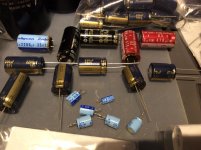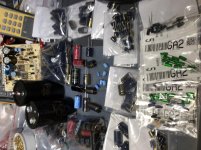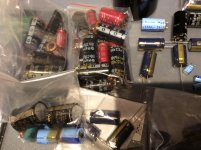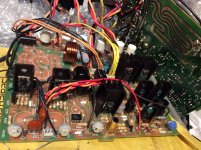Hi.
Little bit new in electronic. I have reasently startet to repair vintage audio amplifiers. When ordering parts, living in Denmark-europe, used mouser.dk. Digikey, farnell and rs-components is likevise an option.
The thing is, when i last week ordered a batch of diffenent capasitors from Mouser, i got capasitors which for the most is 10-15% belov their announced capacity! The manufactor is Panasonic - FC line.
All capasitors above 10µF messured 10-15% belov.
3300µF -> 2980-95
2200µF ->1980-2010µF
1000µF->889-915µF
470µF->425-445µF
220µF->186-195µF
100µ->88-91µF
44µF->37-39µF
When estimatet value is with an +-20% range, its not ment to be like consistent 10-15% beneath the actual statet value! I have ordered up to 40pcs of each capasitor, so its not a singularity when the values is so consistent low.
What is your experiences? Is it only panasonic which "trick" the custumers, or is it the business in general??
Little bit new in electronic. I have reasently startet to repair vintage audio amplifiers. When ordering parts, living in Denmark-europe, used mouser.dk. Digikey, farnell and rs-components is likevise an option.
The thing is, when i last week ordered a batch of diffenent capasitors from Mouser, i got capasitors which for the most is 10-15% belov their announced capacity! The manufactor is Panasonic - FC line.
All capasitors above 10µF messured 10-15% belov.
3300µF -> 2980-95
2200µF ->1980-2010µF
1000µF->889-915µF
470µF->425-445µF
220µF->186-195µF
100µ->88-91µF
44µF->37-39µF
When estimatet value is with an +-20% range, its not ment to be like consistent 10-15% beneath the actual statet value! I have ordered up to 40pcs of each capasitor, so its not a singularity when the values is so consistent low.
What is your experiences? Is it only panasonic which "trick" the custumers, or is it the business in general??
There's no 'trick'. Firstly all the FC series seem to have a -/+ 20% specification. Electrolytics of some years ago were +100% and -50% so things have improved 😉
No electrolytic can be considered a precision part.
Also, you might you get different results using a different meter and you might find that the value is 'different' once the cap has been 'formed' by applying voltage to it.
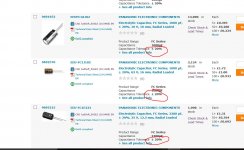
No electrolytic can be considered a precision part.
Also, you might you get different results using a different meter and you might find that the value is 'different' once the cap has been 'formed' by applying voltage to it.

Hi.
Little bit new in electronic. I have reasently startet to repair vintage audio amplifiers. When ordering parts, living in Denmark-europe, used mouser.dk. Digikey, farnell and rs-components is likevise an option.
The thing is, when i last week ordered a batch of diffenent capasitors from Mouser, i got capasitors which for the most is 10-15% belov their announced capacity! The manufactor is Panasonic - FC line.
All capasitors above 10µF messured 10-15% belov.
3300µF -> 2980-95
2200µF ->1980-2010µF
1000µF->889-915µF
470µF->425-445µF
220µF->186-195µF
100µ->88-91µF
44µF->37-39µF
When estimatet value is with an +-20% range, its not ment to be like consistent 10-15% beneath the actual statet value! I have ordered up to 40pcs of each capasitor, so its not a singularity when the values is so consistent low.
What is your experiences? Is it only panasonic which "trick" the custumers, or is it the business in general??
How do you know your cap meter is accurate?
If the difference is consistently the same it points to your test equipment.
Jan
Just forgot to mention:
The new capasitors have been testet at 120hz, with Der DD DE-5000 lcr meter. Esr with 100Khz. Thau and dissipation as well, an i must admit im sad about the result!
All old capasitors, from these old 2 Luxman M05, have been messured, and most off the old parts where closere to statet spec than these new panasonic caps. Brands where all 85degree types Rybycon or Elna for audio. The amplifieres is from mid eighties and is class A construction.
Does the messured capasity of new caps alter to this extend after being used a while? (10-15%)
My point is, that i chose 105degree capasitors, instead off Elna silmic2 /rubycon, because of their thermal specs. But to get capasitors with consistent low capacitance is not acceptable!
Its not an coincidence when all the new panasonic capasitors is at the same range from meeting their statet value. Modern production technics today is much more accurate.
I have nothing against panasonic, butt this is od!!
Im on the edge to return the lot to Mouser, and re-order Elna and rubycon instead. But if this is the therm of all new caps produced, then is little bitt up hillside..
The new capasitors have been testet at 120hz, with Der DD DE-5000 lcr meter. Esr with 100Khz. Thau and dissipation as well, an i must admit im sad about the result!
All old capasitors, from these old 2 Luxman M05, have been messured, and most off the old parts where closere to statet spec than these new panasonic caps. Brands where all 85degree types Rybycon or Elna for audio. The amplifieres is from mid eighties and is class A construction.
Does the messured capasity of new caps alter to this extend after being used a while? (10-15%)
My point is, that i chose 105degree capasitors, instead off Elna silmic2 /rubycon, because of their thermal specs. But to get capasitors with consistent low capacitance is not acceptable!
Its not an coincidence when all the new panasonic capasitors is at the same range from meeting their statet value. Modern production technics today is much more accurate.
I have nothing against panasonic, butt this is od!!
Im on the edge to return the lot to Mouser, and re-order Elna and rubycon instead. But if this is the therm of all new caps produced, then is little bitt up hillside..
Last edited:
Jan.didden:
No, its only the new capasitors. Just to give you an eksample..
40 old Elna 220µF 100V messures 212-235µF (120hz) Esr 0,032-0,825 (100Khz) Most 0.032-0-052Ohms 30 year old parts!!
40 Pana FC 220µf100v " 186-195µf (120hz) Esr 0,084-0,089 (100khz)
When 10 of those capasitors is coupled in parallel, the the difference is almost 300µF
The lcr meter has been testet and is messuring quite accurate!
No, its only the new capasitors. Just to give you an eksample..
40 old Elna 220µF 100V messures 212-235µF (120hz) Esr 0,032-0,825 (100Khz) Most 0.032-0-052Ohms 30 year old parts!!
40 Pana FC 220µf100v " 186-195µf (120hz) Esr 0,084-0,089 (100khz)
When 10 of those capasitors is coupled in parallel, the the difference is almost 300µF
The lcr meter has been testet and is messuring quite accurate!
Last edited:
All old capasitors, from these old 2 Luxman M05, have been messured, and most off the old parts where closere to statet spec than these new panasonic caps. Brands where all 85degree types Rybycon or Elna for audio. The amplifieres is from mid eighties and is class A construction.
What was the tolerance of these old caps though. I doubt they would be -/+20% like modern ones. Far more likely to be +50% and -20% in something that age, and +100%, -50% in really ancient stuff.
You say 'its not acceptable' to receive new caps that are below the marked value but they are within the manufacturers published specs. They are not faulty at all.
Mooly
Im not saing that they are faulty. Im saing that the manufactor perhaps is making an trade of consistently producing capasitors which are minimised in spec, compared to the proclamed value.
Thats not due to production inaccurancy (sorry my bad english), when all capasitors is at range of +-5% at an other value -> 10% below the statet. From my point of view, thats an intend to use the (perhaps) +-20 proclamed "accuracy" at you own advantage.
I really dont care if thats the business, i just want to buy capasitors, which is in the nearby surroundings of the statet value. Not all consistent to low, with the same derriavation.
The end could be that i return all of these capasitors (380Euros), and reorder different brands (elna silmic, rybycon and vishay) to see if the outcome is the same..
Am i the only one with these observations?
Im not saing that they are faulty. Im saing that the manufactor perhaps is making an trade of consistently producing capasitors which are minimised in spec, compared to the proclamed value.
Thats not due to production inaccurancy (sorry my bad english), when all capasitors is at range of +-5% at an other value -> 10% below the statet. From my point of view, thats an intend to use the (perhaps) +-20 proclamed "accuracy" at you own advantage.
I really dont care if thats the business, i just want to buy capasitors, which is in the nearby surroundings of the statet value. Not all consistent to low, with the same derriavation.
The end could be that i return all of these capasitors (380Euros), and reorder different brands (elna silmic, rybycon and vishay) to see if the outcome is the same..
Am i the only one with these observations?
Last edited:
Probably a good time to remind people that there are no free lunches in engineering: do you really think that if you select a 105°C part, it will be superior or equal to an equivalent 85°C one in all respects?All old capasitors, from these old 2 Luxman M05, have been messured, and most off the old parts where closere to statet spec than these new panasonic caps. Brands where all 85degree types Rybycon or Elna for audio. The amplifieres is from mid eighties and is class A construction.
Does the messured capasity of new caps alter to this extend after being used a while? (10-15%)
My point is, that i chose 105degree capasitors, instead off Elna silmic2 /rubycon, because of their thermal specs. But to get capasitors with consistent low capacitance is not acceptable
That's not the way things work: a similar cost, higher temp electrolyte will have less ions available for conduction at room temperature, and will therefore have a higher resistivity.
When given choice, people always tend to go for the higher figure when available, but it is rarely a good idea: there is always some kind of tradeoff somewhere, even when it isn't explicitly apparent.
I use 85°C caps everywhere, except when high temperatures are actually involved. Older caps are in many respects equivalent (or superior) to modern types, except (or because of?) their 85°C (sometimes 70°C) rating. It is no coincidence.
I have made many tests on old caps, EK series, Siemens, etc (see some of my threads or posts), and they are generally of excellent quality. They are quite larger than modern equivalents, but they are also capable of taking much more abuse, and recapping just for the sake of it generally degrades the equipment it is supposed to rejuvenate.
Elvee:
You are absolutely right, i know that the chosen capsitors, isnt as good performance vice, as the more audio grade, physical bigger capasitors. Its an trade off.
These amplifiers gets hot as h... , and den main amplifierboards take alot of thermal abuse. Thats wy i chose 105degree capasitors from panasonic fc line.
I read the specs, and other users eksperiences with these capasitors, and found the trade off acceptable. But never the less, even if the caps isnt the optimal choice, they still have to deliver in the nearby of the statet capasitance.
I think that your are right in your observations of old caps. The most i have seen, is stil inside spec, but some have died due to leakage or to high internal resistance.
And yes, size wise, if you take the audiograde 85 degree capasitors, their physical dimensions is fore the mostly the same as the old parts produced in the 80t..
You are absolutely right, i know that the chosen capsitors, isnt as good performance vice, as the more audio grade, physical bigger capasitors. Its an trade off.
These amplifiers gets hot as h... , and den main amplifierboards take alot of thermal abuse. Thats wy i chose 105degree capasitors from panasonic fc line.
I read the specs, and other users eksperiences with these capasitors, and found the trade off acceptable. But never the less, even if the caps isnt the optimal choice, they still have to deliver in the nearby of the statet capasitance.
I think that your are right in your observations of old caps. The most i have seen, is stil inside spec, but some have died due to leakage or to high internal resistance.
And yes, size wise, if you take the audiograde 85 degree capasitors, their physical dimensions is fore the mostly the same as the old parts produced in the 80t..
Here some picture to give an idea of size of old compared to new parts.
Lead space on replacement capasitors is same as original.
Lead space on replacement capasitors is same as original.
Attachments
It was mentioned earlier, but have you put these in circuits, powered them up, and let them run a while, and THEN remeasure them? This to see if they come closer to value after having been "formed" by the working voltage.
Enzo
I cant retrieve the capasitors after installaion. The Amplifiers is constructet in a way, that main amp boards l/r is placed behind 2 huge heat sinks, with all driver fets mountet on each. Just to disassamble the amplifier (40kg) takes awile!
To do this for checkking the capasitance of newly installed capsitors would be quite time consuming.
And if i find that the values proclamed isnt ok yet, then what? Refund from Mouser for second hand parts?
I must admidt, that i dont wanna install these capasitors. Maybe they are ok, butt it doesnt alter the fact that their value (as new part) is lower that the value recomended/needed in the amplifier.
I cant retrieve the capasitors after installaion. The Amplifiers is constructet in a way, that main amp boards l/r is placed behind 2 huge heat sinks, with all driver fets mountet on each. Just to disassamble the amplifier (40kg) takes awile!
To do this for checkking the capasitance of newly installed capsitors would be quite time consuming.
And if i find that the values proclamed isnt ok yet, then what? Refund from Mouser for second hand parts?
I must admidt, that i dont wanna install these capasitors. Maybe they are ok, butt it doesnt alter the fact that their value (as new part) is lower that the value recomended/needed in the amplifier.
OK, fair enough, so take ONE cap, and connect a couple wires to it and apply working voltage, either from the amp or from another source. Power the cap up and let it charge for an hour. Then disconnect, and discharge. Once discharged, short the cap for a while to allow for soakage to diminish. Now measure the capacitance. If one cap responds to this treatment, we might assume the group of them might as well. if no improvement occurs, then my theory is wrong. If forming them brings them up to value, then the issue is moot. If I read you correctly, you have not yet installed them. They don;t have to be installed to do this test.
When 10 of those capasitors is coupled in parallel, the the difference is almost 300µF
Send them back.
Doubt Mouse will refund shipment cost since they *are* well within spec.
Or write Mouser and ask for a 10% money refund.
Or order Credit Card system to pay $380*0.9=$342 and explain Mouser that you actually paid "$380 +/-10%" .
Or filter each rail with 11 caps in parallel instead of 10, if you think the difference is audible and unbearable, what you seem to imply.
Or just build the amp as intended and stop overthinking.
It is normal for electrolytic capacitors to lose capacitance in storage. The applied dc voltage will restore it. Just hook up a few 9 volt batteries in series for a few days to reform the barrier.
I wouldn't say they purposefully sell under valued caps, but it is certainly possible that their line was producing caps that were under value for a week or something, or as others have said they just need to be formed with voltage, then they will be fine.
Either way, they are within spec, and if your design doesn't account for spec variance, that is just poor engineering.
I would install them, and only then, if they do not perform, would I worry about it.
Either way, they are within spec, and if your design doesn't account for spec variance, that is just poor engineering.
I would install them, and only then, if they do not perform, would I worry about it.
There is also another factor to take into account: the value can be evaluated as per the series circuit equivalent or the parallel one: for low losses caps like PP, the difference will be minuscule, but for E-lytics, depending on the measuring frequency and the losses, the apparent value may be somewhat different.
If the manufacturer measures them in series mode and you measure them in parallel mode, your readings will be systematically lower.
If the manufacturer measures them in series mode and you measure them in parallel mode, your readings will be systematically lower.
Haven't noticed this on the cheap caps I buy.
I needed 100v caps for my slewmaster and ended up buying the cheapest I could find Samwah 22 000uf.
All 8 measured 24 000 uF on my esr meter. 🙂
I needed 100v caps for my slewmaster and ended up buying the cheapest I could find Samwah 22 000uf.
All 8 measured 24 000 uF on my esr meter. 🙂
Enzo
I cant retrieve the capasitors after installaion. The Amplifiers is constructet in a way, that main amp boards l/r is placed behind 2 huge heat sinks, with all driver fets mountet on each. Just to disassamble the amplifier (40kg) takes awile!
To do this for checkking the capasitance of newly installed capsitors would be quite time consuming.
And if i find that the values proclamed isnt ok yet, then what? Refund from Mouser for second hand parts?
I must admidt, that i dont wanna install these capasitors. Maybe they are ok, butt it doesnt alter the fact that their value (as new part) is lower that the value recomended/needed in the amplifier.
The fact that the new caps are a few % below what's on the circuit diagram will not lead to audible differences. The schematic may say 220uF but everybody knows that that is a nominal value and assumes at least +/20% - that's the way it is. A nominally 220uF being 200uF will be as fine, as these are not filter caps I assume but power supply reservoir caps.
It is odd that all new ones are on the lower side but still within spec, and it may be because you measured them unformed, but they will still be fine for the purpose.
You seem to be new to this stuff and may have thought that '220uF is 220uF' but reality is different, and does not subtract from our audio in any way.
To paraphrase a former boss of me: "any customer rep that requires 220uF electrolytics to be between 219uF and 221uF should be quietly replaced by someone who knows what he is talking about'. Not you of course, just to make readers smile.
Jan
- Status
- Not open for further replies.
- Home
- Design & Build
- Parts
- New capacitor value
